Provision of Frequency Response from Wind Farms: A Review
Abstract
1. Introduction
2. Frequency Stability and Wind Power
2.1. Overview of Grid Code Requirements
- and are the frequency limits in which the system can work. These limits are imposed by the applicable grid code.
- and define the tolerance band for the quasi-steady-state frequency level, i.e., the level that is reached because of activation of only primary reserves by means of droop control. In practice, this means that if frequency falls below , the generator will activate 100 % of its primary reserves.
- and are the limits of the dead band for activation of the primary reserves.
- Rate of change of frequency at the time of the disturbance.
- Maximum frequency deviation is the absolute value of frequency deviation from nominal frequency, .
- Frequency nadir is the minimum frequency following a disturbance.
- Frequency nadir time is the time at which the frequency reaches the nadir.
- Quasi-steady-state deviation is the deviation between the nominal frequency value and the final value.
2.2. Inertia and Rate of Change of Frequency
2.3. General Concepts about Harnessing Wind Energy
2.4. Variable-Speed Wind Turbines
- Type 1: Fixed speed wind turbine, with multiple-stage gearbox and squirrel cage induction generator (SCIG).
- Type 2: Limited variable-speed wind turbine with multiple-stage gearbox and wound rotor induction generator (WRIG).
- Type 3: Variable-Speed Wind Turbines (VSWT) using doubly fed induction generator (DFIG) and partial converter.
- Type 4: VSWT with direct drive or single-stage gearbox and full converter.
3. Frequency Control Techniques for Variable-Speed Wind Turbines
3.1. Inertial Response
3.1.1. Hidden Inertia Emulation
- Continuously operating. This is an unrealistic control scheme and it is mentioned only for comparison purposes.
- Under-frequency trigger. This activation scheme produces a trigger signal if the measured frequency is below the frequency threshold.
- Maximum RoCoF trigger. Similarly to RoCoF relays, the trigger signal is activated if is below a certain threshold.
3.1.2. Fast Power Reserve
3.2. Droop Control
3.3. Deloading
3.3.1. Speed Control
3.3.2. Pitch Angle Control
3.4. Combination of Control Strategies
4. Frequency Control Techniques at the Wind Farm Level
4.1. Proposed Solutions without an Energy Storage System
4.2. Proposed Solutions with an Energy Storage System
- Distributed ESS: Small, connected to the DC bus between the two converters on each VSWT.
- Aggregated ESS: Large, connected to the grid.
- Pumped Hydro Storage (PHS);
- Battery-based Energy Storage System (BESS);
- Flywheel Energy Storage (FES);
- Superconducting Magnetic Energy Storage (SMES);
- Supercapacitors (SC).
5. Possibilities and Challenges for the Participation of Wind Power in Frequency Control
5.1. Wind Speed Measurement Noise
5.2. Lack of Universal and Standard Solutions
5.3. Energy Wasting and Unexpected Wind Speed Drops
5.4. Modifications in the Ancillary Services Market
5.5. Grid-Forming Batteries
6. Conclusions
- Hidden inertia emulation and fast power reserve, which try to mimic the short-term inertial response of synchronous generators by means of additional control loops.
- Droop control, a well-known technique which is widely used in traditional generation units for primary frequency control.
- Deloading techniques, including overspeeding and pitching.
- Strategies at the wind farm level, with and without energy storage.
Author Contributions
Funding
Institutional Review Board Statement
Informed Consent Statement
Data Availability Statement
Acknowledgments
Conflicts of Interest
Abbreviations
| RES | Renewable Energy Sources |
| RoCoF | Rate of Change of Frequency, |
| TSO | Transmission System Operator |
| ENTSO-e | European Network of Transmission System Operators for electricity |
| WECS | Wind Energy Conversion System |
| WF | Wind Farm |
| WT | Wind Turbine |
| WTG | Wind Turbine Generator |
| VSWT | Variable-Speed Wind Turbine |
| SCIG | Squirrel Cage Induction Generator |
| WRIG | Wound Rotor Induction Generator |
| PMSG | Permanent Magnet Synchronous Generator |
| DFIG | Doubly Fed Induction Generator |
| IM | Induction Machine |
| SM | Synchronous Machine |
| MPT | Maximum Power Tracking |
| ESS | Energy Storage System |
| PHS | Pumped Hydro Storage |
| BESS | Battery-based Energy Storage System |
| FES | Flywheel Energy Storage System |
| SMES | Superconducting Magnetic Energy Storage |
| SC | Supercapacitors |
| HVDC | High-Voltage Direct Current |
| Mechanical power provided by the prime mover | |
| P | Active power |
| Mechanical torque of the prime mover | |
| Electromagnetic torque | |
| J | Rotational inertia |
| Rotor mechanical speed | |
| Rotor electrical speed | |
| Grid angular frequency | |
| S | Apparent power |
| H | Inertia constant |
References
- Ulbig, A.; Borsche, T.; Andersson, G. Impact of low rotational inertia on power system stability and operation. In Proceedings of the IFAC Proceedings Volumes (IFAC-PapersOnline), 19th IFAC World Congress, Cape Town, Australia, 24–29 August 2014; Volume 19, pp. 7290–7297. [Google Scholar] [CrossRef]
- Gloe, A.; Jauch, C.; Räther, T. Grid Support with Wind Turbines: The Case of the 2019 Blackout in Flensburg. Energies 2021, 14, 1697. [Google Scholar] [CrossRef]
- Van der Veen, R.A.; Hakvoort, R.A. The Electricity Balancing Market: Exploring the Design Challenge. Util. Policy 2016, 43, 186–194. [Google Scholar] [CrossRef]
- Inertia and Rate of Change of Frequency (RoCoF), Version 17; ENTSO-e: Brussels, Belgium, 2021. Available online: https://www.entsoe.eu/publications/system-operations-reports/ (accessed on 10 June 2021).
- Gonzalez-Longatt, F. Frequency Control and Inertial Response Schemes for the Future Power Networks. Green Energy Technol. 2014, 193–231. [Google Scholar] [CrossRef]
- Future of Wind. Deployment, Investment, Technology, Grid Integration and Socio-Economic Aspects. (A Global Energy Transformation Paper); International Renewable Energy Agency (IRENA): Abu Dhabi, United Arab Emirates, 2019. [Google Scholar]
- COMMISSION REGULATION (EU) 2016/ 631—of 14 April 2016—Establishing a Network Code on Requirements for Grid Connection of Generators. Available online: https://eur-lex.europa.eu/legal-content/EN/TXT/?uri=CELEX%3A32016R0631 (accessed on 11 June 2021).
- EirGrid Grid Code, Version 9. 2020. Available online: https://www.eirgridgroup.com/site-files/library/EirGrid/GridCodeVersion9.pdf (accessed on 26 June 2021).
- Fernández-Guillamón, A.; Gómez-Lázaro, E.; Muljadi, E.; Molina-García, Á. Power Systems with High Renewable Energy Sources: A Review of Inertia and Frequency Control Strategies over Time. Renew. Sustain. Energy Rev. 2019, 115. [Google Scholar] [CrossRef]
- COMMISSION REGULATION (EU) 2017/ 2195—of 23 November 2017—Establishing a Guideline on Electricity Balancing. p. 48. Available online: https://eur-lex.europa.eu/legal-content/EN/TXT/?uri=CELEX%3A32017R2195 (accessed on 14 June 2021).
- Operator, N.G.E.S. The Grid Code. 2021. Available online: https://www.nationalgrideso.com/document/162271/download (accessed on 13 October 2021).
- Dreidy, M.; Mokhlis, H.; Mekhilef, S. Inertia Response and Frequency Control Techniques for Renewable Energy Sources: A Review. Renew. Sustain. Energy Rev. 2017, 69, 144–155. [Google Scholar] [CrossRef]
- Luo, X.; Wang, J.; Dooner, M.; Clarke, J. Overview of Current Development in Electrical Energy Storage Technologies and the Application Potential in Power System Operation. Appl. Energy 2015, 137, 511–536. [Google Scholar] [CrossRef]
- Kundur, P.; Paserba, J.; Ajjarapu, V.; Andersson, G.; Bose, A.; Canizares, C.; Hatziargyriou, N.; Hill, D.; Stankovic, A.; Taylor, C.; et al. Definition and Classification of Power System Stability. IEEE Trans. Power Syst. 2004, 19, 1387–1401. [Google Scholar] [CrossRef]
- Díaz-González, F.; Hau, M.; Sumper, A.; Gomis-Bellmunt, O. Participation of Wind Power Plants in System Frequency Control: Review of Grid Code Requirements and Control Methods. Renew. Sustain. Energy Rev. 2014, 34, 551–564. [Google Scholar] [CrossRef]
- TenneT. Requirement for Offshore Grid Connections in the Grid of Tennet TSO GmbH. 2012. Available online: https://www.tennet.eu/fileadmin/user_upload/The_Electricity_Market/German_Market/Grid_customers/tennet_tso_gmbh-asn-eng_21122012_final_1_.pdf (accessed on 13 October 2021).
- Erlich, I.; Wilch, M. Primary frequency control by wind turbines. In IEEE PES General Meeting; IEEE: Minneapolis, MN, USA, 2010; pp. 1–8. [Google Scholar] [CrossRef]
- Morren, J.; de Haan, S.; Kling, W.; Ferreira, J. Wind Turbines Emulating Inertia and Supporting Primary Frequency Control. IEEE Trans. Power Syst. 2006, 21, 433–434. [Google Scholar] [CrossRef]
- Ullah, N.; Thiringer, T.; Karlsson, D. Temporary Primary Frequency Control Support by Variable Speed Wind Turbines—Potential and Applications. IEEE Trans. Power Syst. 2008, 23, 601–612. [Google Scholar] [CrossRef]
- De Almeida, R.; Peças Lopes, J. Participation of Doubly Fed Induction Wind Generators in System Frequency Regulation. IEEE Trans. Power Syst. 2007, 22, 944–950. [Google Scholar] [CrossRef]
- Sun, Y.Z.; Zhang, Z.S.; Li, G.J.; Lin, J. Review on frequency control of power systems with wind power penetration. In Proceedings of the 2010 International Conference on Power System Technology: Technological Innovations Making Power Grid Smarter, POWERCON2010, Zhejiang, China, 24–28 October 2010. [Google Scholar] [CrossRef]
- Doherty, R.; Mullane, A.; Nolan, G.; Burke, D.; Bryson, A.; O’Malley, M. An Assessment of the Impact of Wind Generation on System Frequency Control. IEEE Trans. Power Syst. 2010, 25, 452–460. [Google Scholar] [CrossRef]
- Johnson, A. Grid Code Frequency Response Working Group System Inertia. p. 17. Available online: https://www.nationalgrid.com/sites/default/files/documents/16890-Meeting%208%20-%20Inertia%20presentation.pdf (accessed on 13 October 2021).
- Commission for Energy Regulation (Ireland). Rate of Change of Frequency (RoCoF) Modification to the Grid Code. Available online: https://www.cru.ie/wp-content/uploads/2014/07/CER14081-ROCOF-Decision-Paper-FINAL-FOR-PUBLICATION.pdf (accessed on 13 October 2021).
- Manwell, J.F.; McGowan, J.G.; Rogers, A.L. Wind Energy Explained: Theory, Design and Application; Wiley: Hoboken, NJ, USA, 2010. [Google Scholar]
- Heier, S.; Heier, S. Grid Integration of Wind ENERGY Conversion Systems, 2nd ed.; John Wiley & Sons: Chichester, UK, 2006; Chapter xix; p. 426. [Google Scholar]
- Cortajarena, J.; Barambones, O.; Alkorta, P.; Cortajarena, J. Grid Frequency and Amplitude Control Using Dfig Wind Turbines in a Smart Grid. Mathematics 2021, 9, 143. [Google Scholar] [CrossRef]
- Reyes, V.; Rodriguez, J.; Carranza, O.; Ortega, R. Review of mathematical models of both the power coefficient and the torque coefficient in wind turbines. In Proceedings of the IEEE International Symposium on Industrial Electronics, Buzios, Brazil, 3–5 June 2015; Volume 2015, pp. 1458–1463. [Google Scholar] [CrossRef]
- Shokrzadeh, S.; Jafari Jozani, M.; Bibeau, E. Wind Turbine Power Curve Modeling Using Advanced Parametric and Nonparametric Methods. IEEE Trans. Sustain. Energy 2014, 5, 1262–1269. [Google Scholar] [CrossRef]
- Lydia, M.; Kumar, S.; Selvakumar, A.; Prem Kumar, G. A Comprehensive Review on Wind Turbine Power Curve Modeling Techniques. Renew. Sustain. Energy Rev. 2014, 30, 452–460. [Google Scholar] [CrossRef]
- Junyent-Ferré, A.; Gomis-Bellmunt, O.; Sumper, A.; Sala, M.; Mata, M. Modeling and Control of the Doubly Fed Induction Generator Wind Turbine. Simul. Model. Pract. Theory 2010, 18, 1365–1381. [Google Scholar] [CrossRef]
- Yang, B.; Yu, T.; Shu, H.; Dong, J.; Jiang, L. Robust Sliding-Mode Control of Wind Energy Conversion Systems for Optimal Power Extraction via Nonlinear Perturbation Observers. Appl. Energy 2018, 210, 711–723. [Google Scholar] [CrossRef]
- Zhang, J.; Cheng, M.; Chen, Z.; Fu, X. Pitch angle control for variable speed wind turbines. In Proceedings of the 3rd International Conference on Deregulation and Restructuring and Power Technologies, DRPT 2008, Nanjing, China, 6–9 April 2008; pp. 2691–2696. [Google Scholar] [CrossRef]
- Van, T.; Nguyen, T.; Lee, D.C. Advanced Pitch Angle Control Based on Fuzzy Logic for Variable-Speed Wind Turbine Systems. IEEE Trans. Energy Convers. 2015, 30, 578–587. [Google Scholar] [CrossRef]
- Frandsen, S.; Barthelmie, R.; Pryor, S.; Rathmann, O.; Larsen, S.; Højstrup, J.; Thøgersen, M. Analytical Modelling of Wind Speed Deficit in Large Offshore Wind Farms. Wind Energy 2006, 9, 39–53. [Google Scholar] [CrossRef]
- Singh, M.; Santoso, S. Dynamic Models for Wind Turbines and Wind Power Plants; Technical Report NREL/SR-5500-52780, 1028524. 2011. Available online: https://www.nrel.gov/docs/fy12osti/52780.pdf (accessed on 13 October 2021).
- Ellis, A.; Kazachkov, Y.; Muljadi, E.; Pourbeik, P.; Sanchez-Gasca, J. Description and technical specifications for generic WTG models—A status report. In Proceedings of the 2011 IEEE/PES Power Systems Conference and Exposition, PSCE 2011, Phoenix, AZ, USA, 20–23 March 2011. [Google Scholar] [CrossRef]
- Cheng, M.; Zhu, Y. The State of the Art of Wind Energy Conversion Systems and Technologies: A Review. Energy Convers. Manag. 2014, 88, 332–347. [Google Scholar] [CrossRef]
- Ekanayake, J.; Jenkins, N. Comparison of the Response of Doubly Fed and Fixed-Speed Induction Generator Wind Turbines to Changes in Network Frequency. IEEE Trans. Energy Convers. 2004, 19, 800–802. [Google Scholar] [CrossRef]
- Cardenas, R.; Pena, R.; Alepuz, S.; Asher, G. Overview of Control Systems for the Operation of DFIGs in Wind Energy Applications. IEEE Trans. Ind. Electron. 2013, 60, 2776–2798. [Google Scholar] [CrossRef]
- Tapia, A.; Tapia, G.; Ostolaza, J.X.; Sáenz, J.R. Modeling and Control of a Wind Turbine Driven Doubly Fed Induction Generator. IEEE Trans. Energy Convers. 2003, 18, 11. [Google Scholar] [CrossRef]
- Lalor, G.; Mullane, A.; O’Malley, M. Frequency Control and Wind Turbine Technologies. IEEE Trans. Power Syst. 2005, 20, 9. [Google Scholar] [CrossRef]
- Mullane, A.; O’Malley, M. The Inertial Response of Induction-Machine-Based Wind Turbines. IEEE Trans. Power Syst. 2005, 20, 1496–1503. [Google Scholar] [CrossRef]
- Slootweg, J.; Polinder, H.; Kling, W. Dynamic modelling of a wind turbine with doubly fed induction generator. In Proceedings of the IEEE Power Engineering Society Transmission and Distribution Conference, Vancouver, BC, Canada, 15–19 July 2001; Volume 1, pp. 644–649. [Google Scholar]
- Ananth, D.; Nagesh Kumar, G. Tip Speed Ratio Based MPPT Algorithm and Improved Field Oriented Control for Extracting Optimal Real Power and Independent Reactive Power Control for Grid Connected Doubly Fed Induction Generator. Int. J. Electr. Comput. Eng. 2016, 6, 1319–1331. [Google Scholar] [CrossRef]
- Amrane, F.; Chaiba, A.; Francois, B.; Babes, B. Experimental design of stand-alone field oriented control for WECS in variable speed DFIG-based on hysteresis current controller. In Proceedings of the 2017 15th International Conference on Electrical Machines, Drives and Power Systems, ELMA 2017—Proceedings, Sofia, Bulgaria, 1–3 June 2017; pp. 304–308. [Google Scholar] [CrossRef]
- Djilali, L.; Sanchez, E.; Belkheiri, M. Real-Time Implementation of Sliding-Mode Field-Oriented Control for a DFIG-Based Wind Turbine. Int. Trans. Electr. Energy Syst. 2018, 28. [Google Scholar] [CrossRef]
- Poitiers, F.; Bouaouiche, T.; Machmoum, M. Advanced Control of a Doubly-Fed Induction Generator for Wind Energy Conversion. Electr. Power Syst. Res. 2009, 79, 1085–1096. [Google Scholar] [CrossRef]
- Kaloi, G.; Wang, J.; Baloch, M. Active and Reactive Power Control of the Doubly Fed Induction Generator Based on Wind Energy Conversion System. Energy Rep. 2016, 2, 194–200. [Google Scholar] [CrossRef]
- Evangelista, C.; Valenciaga, F.; Puleston, P. Active and Reactive Power Control for Wind Turbine Based on a MIMO 2-Sliding Mode Algorithm with Variable Gains. IEEE Trans. Energy Convers. 2013, 28, 682–689. [Google Scholar] [CrossRef]
- Gaillard, A.; Poure, P.; Saadate, S.; Machmoum, M. Variable Speed DFIG Wind Energy System for Power Generation and Harmonic Current Mitigation. Renew. Energy 2009, 34, 1545–1553. [Google Scholar] [CrossRef]
- Soued, S.; Ramadan, H.; Becherif, M. Dynamic Behavior Analysis for Optimally Tuned On-Grid DFIG Systems. Energy Procedia 2019, 162, 339–348. [Google Scholar] [CrossRef]
- Yu, S.; Emami, K.; Fernando, T.; Iu, H.; Wong, K. State Estimation of Doubly Fed Induction Generator Wind Turbine in Complex Power Systems. IEEE Trans. Power Syst. 2016, 31, 4935–4944. [Google Scholar] [CrossRef]
- Cortajarena, J.; de Marcos, J.; Alkorta, P.; Barambones, O.; Cortajarena, J. DFIG wind turbine grid connected for frequency and amplitude control in a smart grid. In Proceedings of the 2018 IEEE International Conference on Industrial Electronics for Sustainable Energy Systems, IESES 2018, Hamilton, New Zealand, 31 January–2 February 2018; Volume 2018, pp. 362–369. [Google Scholar] [CrossRef]
- Gautam, D.; Goel, L.; Ayyanar, R.; Vittal, V.; Harbour, T. Control Strategy to Mitigate the Impact of Reduced Inertia Due to Doubly Fed Induction Generators on Large Power Systems. IEEE Trans. Power Syst. 2011, 26, 214–224. [Google Scholar] [CrossRef]
- Martinez, J.; Arnaltes, S.; Alonso-Martinez, J.; Amenedo, J. Contribution of Wind Farms to the Stability of Power Systems with High Penetration of Renewables. Energies 2021, 14, 2207. [Google Scholar] [CrossRef]
- Conroy, J.; Watson, R. Frequency Response Capability of Full Converter Wind Turbine Generators in Comparison to Conventional Generation. IEEE Trans. Power Syst. 2008, 23, 649–656. [Google Scholar] [CrossRef]
- Uehara, A.; Pratap, A.; Goya, T.; Senjyu, T.; Yona, A.; Urasaki, N.; Funabashi, T. A Coordinated Control Method to Smooth Wind Power Fluctuations of a PMSG-Based WECS. IEEE Trans. Energy Convers. 2011, 26, 550–558. [Google Scholar] [CrossRef]
- Sanchez, A.; Molina, M.; Rizzato Lede, A. Dynamic Model of Wind Energy Conversion Systems with PMSG-Based Variable-Speed Wind Turbines for Power System Studies. Int. J. Hydrog. Energy 2012, 37, 10064–10069. [Google Scholar] [CrossRef]
- Licari, J.; Ekanayake, J.; Moore, I. Inertia Response from Full-Power Converter-Based Permanent Magnet Wind Generators. J. Mod. Power Syst. Clean Energy 2013, 1, 26–33. [Google Scholar] [CrossRef]
- Revel, G.; Leon, A.; Alonso, D.; Moiola, J. Dynamics and Stability Analysis of a Power System with a PMSG-Based Wind Farm Performing Ancillary Services. IEEE Trans. Circuits Syst. I Regul. Pap. 2014, 61, 2182–2193. [Google Scholar] [CrossRef]
- Wang, Y.; Meng, J.; Zhang, X.; Xu, L. Control of PMSG-Based Wind Turbines for System Inertial Response and Power Oscillation Damping. IEEE Trans. Sustain. Energy 2015, 6, 565–574. [Google Scholar] [CrossRef]
- Gonzalez-Longatt, F.; Bonfiglio, A.; Procopio, R.; Verduci, B. Evaluation of inertial response controllers for full-rated power converter wind turbine (type 4). In Proceedings of the IEEE Power and Energy Society General Meeting, Boston, MA, USA, 17–21 July 2016; Volume 2016. [Google Scholar] [CrossRef]
- Asensio, A.; Gómez, S.; Rodriguez-Amenedo, J.; Plaza, M.; Carrasco, J.G.; de Las Morenas, J.M. A Voltage and Frequency Control Strategy for Stand-Alone Full Converter Wind Energy Conversion Systems. Energies 2018, 11, 474. [Google Scholar] [CrossRef]
- Muftau, B.; Fazeli, M.; Egwebe, A. Stability Analysis of a PMSG Based Virtual Synchronous Machine. Electr. Power Syst. Res. 2020, 180. [Google Scholar] [CrossRef]
- Eriksson, R.; Modig, N.; Elkington, K. Synthetic Inertia versus Fast Frequency Response: A Definition. IET Renew. Power Gener. 2018, 12, 507–514. [Google Scholar] [CrossRef]
- Mauricio, J.; Marano, A.; Gómez-Expósito, A.; Ramos, J. Frequency Regulation Contribution through Variable-Speed Wind Energy Conversion Systems. IEEE Trans. Power Syst. 2009, 24, 173–180. [Google Scholar] [CrossRef]
- Guo, F.; Schlipf, D. A Spectral Model of Grid Frequency for Assessing the Impact of Inertia Response on Wind Turbine Dynamics. Energies 2021, 14, 2492. [Google Scholar] [CrossRef]
- Ochoa, D.; Martinez, S. Analytical Approach to Understanding the Effects of Implementing Fast-Frequency Response by Wind Turbines on the Short-Term Operation of Power Systems. Energies 2021, 14, 3660. [Google Scholar] [CrossRef]
- Gonzalez-Longatt, F. Activation schemes of synthetic inertia controller on full converter wind turbine (type 4). In Proceedings of the IEEE Power and Energy Society General Meeting, Denver, CO, USA, 26–30 July 2015; Volume 2015. [Google Scholar] [CrossRef]
- Teninge, A.; Jecu, C.; Roye, D.; Bacha, S.; Duval, J.; Belhomme, R. Contribution to Frequency Control through Wind Turbine Inertial Energy Storage. IET Renew. Power Gener. 2009, 3, 358–370. [Google Scholar] [CrossRef]
- Keung, P.K.; Li, P.; Banakar, H.; Ooi, B. Kinetic Energy of Wind-Turbine Generators for System Frequency Support. IEEE Trans. Power Syst. 2009, 24, 279–287. [Google Scholar] [CrossRef]
- Ochoa, D.; Martinez, S. Fast-Frequency Response Provided by DFIG-Wind Turbines and Its Impact on the Grid. IEEE Trans. Power Syst. 2017, 32, 4002–4011. [Google Scholar] [CrossRef]
- Zhang, S.; Mishra, Y.; Yuan, B.; Zhao, J.; Shahidehpour, M. Primary Frequency Controller with Prediction-Based Droop Coefficient for Wind-Storage Systems under Spot Market Rules. Energies 2018, 11, 2340. [Google Scholar] [CrossRef]
- Arani, M.; Mohamed, Y.R. Analysis and Impacts of Implementing Droop Control in Dfig-Based Wind Turbines on Microgrid/Weak-Grid Stability. IEEE Trans. Power Syst. 2015, 30, 385–396. [Google Scholar] [CrossRef]
- Loukarakis, E.; Margaris, I.; Moutis, P. Frequency control support and participation methods provided by wind generation. In Proceedings of the 2009 IEEE Electrical Power and Energy Conference, EPEC 2009, Montreal, QC, Canada, 22–23 October 2009. [Google Scholar] [CrossRef]
- Chang-Chien, L.R.; Sun, C.C.; Yeh, Y.J. Modeling of Wind Farm Participation in AGC. IEEE Trans. Power Syst. 2014, 29, 1204–1211. [Google Scholar] [CrossRef]
- Žertek, A.; Verbič, G.; Pantoš, M. A Novel Strategy for Variable-Speed Wind Turbines’ Participation in Primary Frequency Control. IEEE Trans. Sustain. Energy 2012, 3, 791–799. [Google Scholar] [CrossRef]
- Zhang, Z.S.; Sun, Y.Z.; Lin, J.; Li, G.J. Coordinated Frequency Regulation by Doubly Fed Induction Generator-Based Wind Power Plants. IET Renew. Power Gener. 2012, 6, 38–47. [Google Scholar] [CrossRef]
- Vidyanandan, K.; Senroy, N. Primary Frequency Regulation by Deloaded Wind Turbines Using Variable Droop. IEEE Trans. Power Syst. 2013, 28, 837–846. [Google Scholar] [CrossRef]
- Alsharafi, A.; Besheer, A.; Emara, H. Primary Frequency Response Enhancement for Future Low Inertia Power Systems Using Hybrid Control Technique. Energies 2018, 11, 699. [Google Scholar] [CrossRef]
- Boyle, J.; Littler, T.; Muyeen, S.; Foley, A. An Alternative Frequency-Droop Scheme for Wind Turbines That Provide Primary Frequency Regulation via Rotor Speed Control. Int. J. Electr. Power Energy Syst. 2021, 133. [Google Scholar] [CrossRef]
- Geyler, M.; Caselitz, P. Robust Multivariable Pitch Control Design for Load Reduction on Large Wind Turbines. J. Sol. Energy Eng. Trans. ASME 2008, 130, 0310141–03101412. [Google Scholar] [CrossRef]
- Yang, P.; He, B.; Wang, B.; Dong, X.; Liu, W.; Zhang, J.; Wu, Z.; Liu, J.X.; Qin, Z. Coordinated Control of Rotor Kinetic Energy and Pitch Angle for Large-Scale Doubly Fed Induction Generators Participating in System Primary Frequency Regulation. IET Renew. Power Gener. 2021, 15, 1836–1847. [Google Scholar] [CrossRef]
- Zhao, X.; Lin, Z.; Fu, B.; Gong, S. Research on Frequency Control Method for Micro-Grid with a Hybrid Approach of FFR-OPPT and Pitch Angle of Wind Turbine. Int. J. Electr. Power Energy Syst. 2021, 127. [Google Scholar] [CrossRef]
- Luo, H.; Hu, Z.; Zhang, H.; Chen, H. Coordinated Active Power Control Strategy for Deloaded Wind Turbines to Improve Regulation Performance in AGC. IEEE Trans. Power Syst. 2019, 34, 98–108. [Google Scholar] [CrossRef]
- Sonkar, P.; Rahi, O. Contribution of Wind Power Plants in Grid Frequency Regulation: Current Perspective and Future Challenges. Wind Eng. 2021, 45, 442–456. [Google Scholar] [CrossRef]
- Cheng, Y.; Azizipanah-Abarghooee, R.; Azizi, S.; Ding, L.; Terzija, V. Smart Frequency Control in Low Inertia Energy Systems Based on Frequency Response Techniques: A Review. Appl. Energy 2020, 279. [Google Scholar] [CrossRef]
- Etxegarai, A.; Eguia, P.; Torres, E.; Buigues, G.; Iturregi, A. Evaluation of short-term frequency control in isolated power grids with increasing penetration of renewable energy sources. In Proceedings of the IEEE PES PowerAfrica Conference, PowerAfrica 2016, Livingstone, Zambia, 28 June–3 July 2016; pp. 213–217. [Google Scholar] [CrossRef]
- Hoseinzadeh, B.; Chen, Z. Intelligent Load-Frequency Control Contribution of Wind Turbine in Power System Stability. IEEE EuroCon 2013, 2013, 1124–1128. [Google Scholar] [CrossRef]
- Liu, F.; Liu, Z.; Mei, S.; Wei, W.; Yao, Y. ESO-Based Inertia Emulation and Rotor Speed Recovery Control for DFIGs. IEEE Trans. Energy Convers. 2017, 32, 1209–1219. [Google Scholar] [CrossRef]
- Hwang, M.; Muljadi, E.; Jang, G.; Kang, Y. Disturbance-Adaptive Short-Term Frequency Support of a DFIG Associated with the Variable Gain Based on the ROCOF and Rotor Speed. IEEE Trans. Power Syst. 2017, 32, 1873–1881. [Google Scholar] [CrossRef]
- Slootweg, J.; Kling, W. Aggregated modelling of wind parks in power system dynamics simulations. In Proceedings of the 2003 IEEE Bologna PowerTech - Conference Proceedings, Bologna, Italy, 23–26 June 2003; Volume 3, pp. 626–631. [Google Scholar] [CrossRef]
- Fernández, L.; García, C.; Saenz, J.; Jurado, F. Equivalent Models of Wind Farms by Using Aggregated Wind Turbines and Equivalent Winds. Energy Convers. Manag. 2009, 50, 691–704. [Google Scholar] [CrossRef]
- Conroy, J.; Watson, R. Aggregate Modelling of Wind Farms Containing Full-Converter Wind Turbine Generators with Permanent Magnet Synchronous Machines: Transient Stability Studies. IET Renew. Power Gener. 2009, 3, 39–52. [Google Scholar] [CrossRef]
- Ghosh, S.; Kamalasadan, S.; Senroy, N.; Enslin, J. Doubly Fed Induction Generator (DFIG)-Based Wind Farm Control Framework for Primary Frequency and Inertial Response Application. IEEE Trans. Power Syst. 2016, 31, 1861–1871. [Google Scholar] [CrossRef]
- Dong, Z.; Li, Z.; Dong, Y.; Jiang, S.; Ding, Z. Fully-Distributed Deloading Operation of DFIG-Based Wind Farm for Load Sharing. IEEE Trans. Sustain. Energy 2021, 12, 430–440. [Google Scholar] [CrossRef]
- Zhang, W.; Fang, K. Controlling Active Power of Wind Farms to Participate in Load Frequency Control of Power Systems. IET Gener. Transm. Distrib. 2017, 11, 2194–2203. [Google Scholar] [CrossRef]
- Margaris, I.; Papathanassiou, S.; Hatziargyriou, N.; Hansen, A.; Sorensen, P. Frequency Control in Autonomous Power Systems with High Wind Power Penetration. IEEE Trans. Sustain. Energy 2012, 3, 189–199. [Google Scholar] [CrossRef]
- Liu, T.; Pan, W.; Quan, R.; Liu, M. A Variable Droop Frequency Control Strategy for Wind Farms That Considers Optimal Rotor Kinetic Energy. IEEE Access 2019, 7, 68636–68645. [Google Scholar] [CrossRef]
- Liu, J.; Wen, J.; Yao, W.; Long, Y. Solution to Short-Term Frequency Response of Wind Farms by Using Energy Storage Systems. IET Renew. Power Gener. 2016, 10, 669–678. [Google Scholar] [CrossRef]
- Dunn, B.; Kamath, H.; Tarascon, J.M. Electrical Energy Storage for the Grid: A Battery of Choices. Science 2011, 334, 928–935. [Google Scholar] [CrossRef]
- Zakeri, B.; Syri, S. Electrical Energy Storage Systems: A Comparative Life Cycle Cost Analysis. Renew. Sustain. Energy Rev. 2015, 42, 569–596. [Google Scholar] [CrossRef]
- Zhao, H.; Wu, Q.; Hu, S.; Xu, H.; Rasmussen, C. Review of Energy Storage System for Wind Power Integration Support. Appl. Energy 2015, 137, 545–553. [Google Scholar] [CrossRef]
- Ould Amrouche, S.; Rekioua, D.; Rekioua, T.; Bacha, S. Overview of Energy Storage in Renewable Energy Systems. Int. J. Hydrog. Energy 2016, 41, 20914–20927. [Google Scholar] [CrossRef]
- Faisal, M.; Hannan, M.; Ker, P.; Hussain, A.; Mansor, M.; Blaabjerg, F. Review of Energy Storage System Technologies in Microgrid Applications: Issues and Challenges. IEEE Access 2018, 6, 35143–35164. [Google Scholar] [CrossRef]
- Larcher, D.; Tarascon, J.M. Towards Greener and More Sustainable Batteries for Electrical Energy Storage. Nat. Chem. 2015, 7, 19–29. [Google Scholar] [CrossRef]
- Martínez-Lucas, G.; Sarasúa, J.; Sánchez-Fernández, J. Frequency Regulation of a Hybridwind-Hydro Power Plant in an Isolated Power System. Energies 2018, 11, 239. [Google Scholar] [CrossRef]
- Frydrychowicz-Jastrzȩbska, G. El Hierro Renewable Energy Hybrid System: A Tough Compromise. Energies 2018, 11, 2812. [Google Scholar] [CrossRef]
- Mao, J.; Jafari, M.; Botterud, A. Planning Low-Carbon Distributed Power Systems: Evaluating the Role of Energy Storage. Energy 2020, 238. [Google Scholar] [CrossRef]
- Hesse, H.; Schimpe, M.; Kucevic, D.; Jossen, A. Lithium-Ion Battery Storage for the Grid—A Review of Stationary Battery Storage System Design Tailored for Applications in Modern Power Grids. Energies 2017, 10, 2107. [Google Scholar] [CrossRef]
- Han, J.; Solanki, S.; Solanki, J. Coordinated Predictive Control of a Wind/Battery Microgrid System. IEEE J. Emerg. Sel. Top. Power Electron. 2013, 1, 296–305. [Google Scholar] [CrossRef]
- Aghamohammadi, M.; Abdolahinia, H. A New Approach for Optimal Sizing of Battery Energy Storage System for Primary Frequency Control of Islanded Microgrid. Int. J. Electr. Power Energy Syst. 2014, 54, 325–333. [Google Scholar] [CrossRef]
- Ma, T.; Yang, H.; Lu, L. A Feasibility Study of a Stand-Alone Hybrid Solar-Wind-Battery System for a Remote Island. Appl. Energy 2014, 121, 149–158. [Google Scholar] [CrossRef]
- Oyegoke, S.; Maniatopoulos, M.; Keates, S.; Habtay, Y. Frequency and voltage control of island system using power hardware in the loop. In Proceedings of the 8th International Conference on Renewable Energy Research and Applications, ICRERA 2019, Brasov, Romania, 3–6 November 2019; pp. 587–592. [Google Scholar] [CrossRef]
- Johnston, L.; Díaz-González, F.; Gomis-Bellmunt, O.; Corchero-García, C.; Cruz-Zambrano, M. Methodology for the Economic Optimisation of Energy Storage Systems for Frequency Support in Wind Power Plants. Appl. Energy 2015, 137, 660–669. [Google Scholar] [CrossRef]
- Mountain, B.; Percy, S. Inertia and System Strength in the National Energy Market; The Australia Institute: Canberra, Australia, 2021. [Google Scholar] [CrossRef]
- Fan, F.; Zorzi, G.; Campos-Gaona, D.; Burt, G.; Anaya-Lara, O.; Nwobu, J.; Madariaga, A. Sizing and Coordination Strategies of Battery Energy Storage System Co-Located with Wind Farm: The Uk Perspective. Energies 2021, 14, 1439. [Google Scholar] [CrossRef]
- Diaz-Gonzalez, F.; Bianchi, F.; Sumper, A.; Gomis-Bellmunt, O. Control of a Flywheel Energy Storage System for Power Smoothing in Wind Power Plants. IEEE Trans. Energy Convers. 2014, 29, 204–214. [Google Scholar] [CrossRef]
- Nadour, M.; Essadki, A.; Nasser, T.; Fdaili, M. Robust Coordinated Control Using Backstepping of Flywheel Energy Storage System and DFIG for Power Smoothing in Wind Power Plants. Int. J. Power Electron. Drive Syst. 2019, 10, 1110–1122. [Google Scholar] [CrossRef][Green Version]
- Zhai, Y.; Zhang, J.; Tan, Z.; Liu, X.; Shen, B.; Coombs, T.; Liu, P.; Huang, S. Research on the Application of Superconducting Magnetic Energy Storage in the Wind Power Generation System for Smoothing Wind Power Fluctuations. IEEE Trans. Appl. Supercond. 2021, 31. [Google Scholar] [CrossRef]
- Li, J.; Gee, A.; Zhang, M.; Yuan, W. Analysis of Battery Lifetime Extension in a SMES-Battery Hybrid Energy Storage System Using a Novel Battery Lifetime Model. Energy 2015, 86, 175–185. [Google Scholar] [CrossRef]
- Li, J.; Xiong, R.; Yang, Q.; Liang, F.; Zhang, M.; Yuan, W. Design/Test of a Hybrid Energy Storage System for Primary Frequency Control Using a Dynamic Droop Method in an Isolated Microgrid Power System. Appl. Energy 2017, 201, 257–269. [Google Scholar] [CrossRef]
- Abbey, C.; Joos, G. Supercapacitor Energy Storage for Wind Energy Applications. IEEE Trans. Ind. Appl. 2007, 43, 769–776. [Google Scholar] [CrossRef]
- Delille, G.; François, B.; Malarange, G. Dynamic Frequency Control Support by Energy Storage to Reduce the Impact of Wind and Solar Generation on Isolated Power System’s Inertia. IEEE Trans. Sustain. Energy 2012, 3, 931–939. [Google Scholar] [CrossRef]
- Negnevitsky, M.; Nguyen, D.; Piekutowski, M. Risk Assessment for Power System Operation Planning With High Wind Power Penetration. IEEE Trans. Power Syst. 2015, 30, 1359–1368. [Google Scholar] [CrossRef]
- Attya, A.; Dominguez-Garcia, J.; Anaya-Lara, O. A Review on Frequency Support Provision by Wind Power Plants: Current and Future Challenges. Renew. Sustain. Energy Rev. 2018, 81, 2071–2087. [Google Scholar] [CrossRef]
- Simley, E.; Fürst, H.; Haizmann, F.; Schlipf, D. Optimizing Lidars for Wind Turbine Control Applications-Results from the IEA Wind Task 32 Workshop. Remote Sens. 2018, 10, 863. [Google Scholar] [CrossRef]
- Zuo, Y.; Yuan, Z.; Sossan, F.; Zecchino, A.; Cherkaoui, R.; Paolone, M. Performance Assessment of Grid-Forming and Grid-Following Converter-Interfaced Battery Energy Storage Systems on Frequency Regulation in Low-Inertia Power Grids. Sustain. Energy Grids Netw. 2021, 27. [Google Scholar] [CrossRef]
- Datta, U.; Kalam, A.; Shi, J. The Relevance of Large-Scale Battery Energy Storage (BES) Application in Providing Primary Frequency Control with Increased Wind Energy Penetration. J. Energy Storage 2019, 23, 9–18. [Google Scholar] [CrossRef]

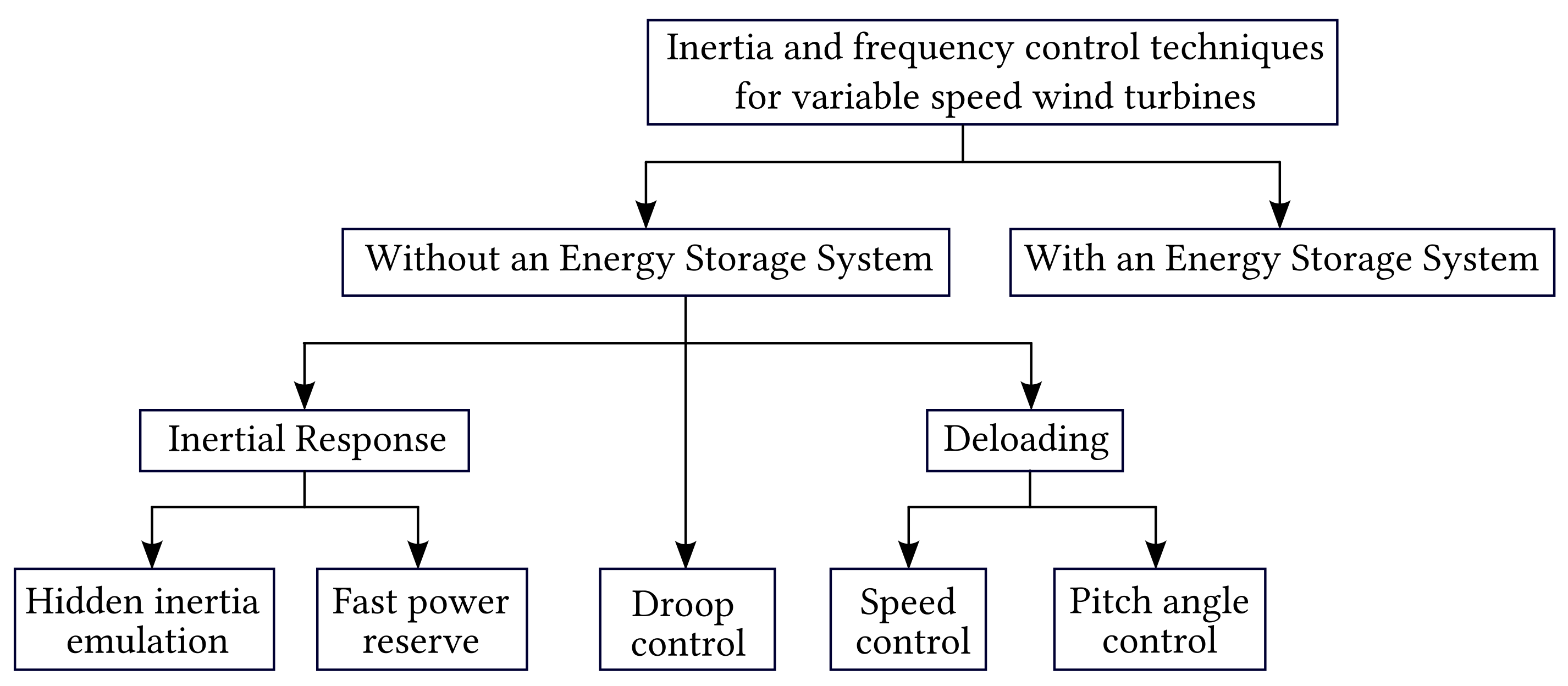
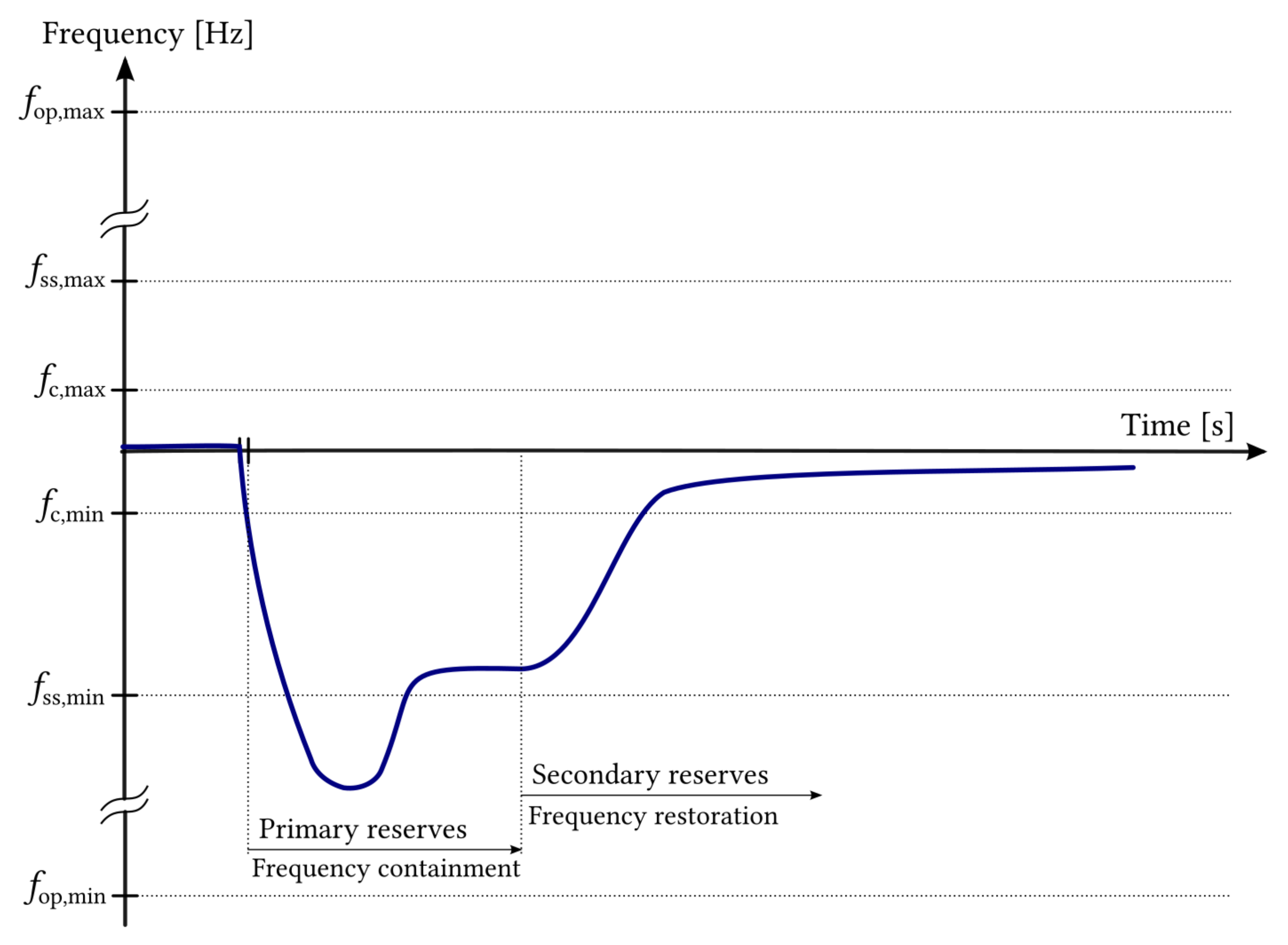

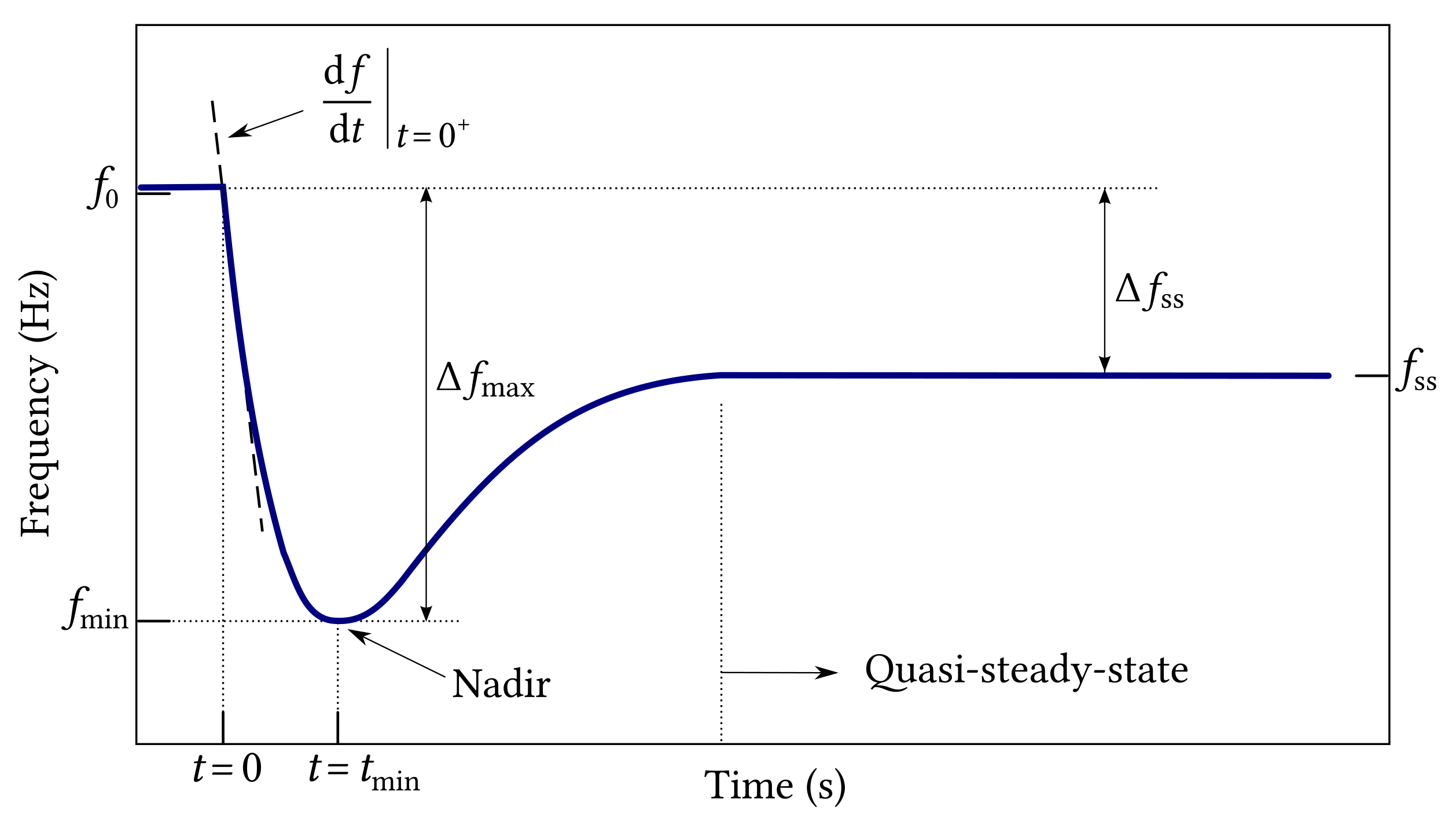
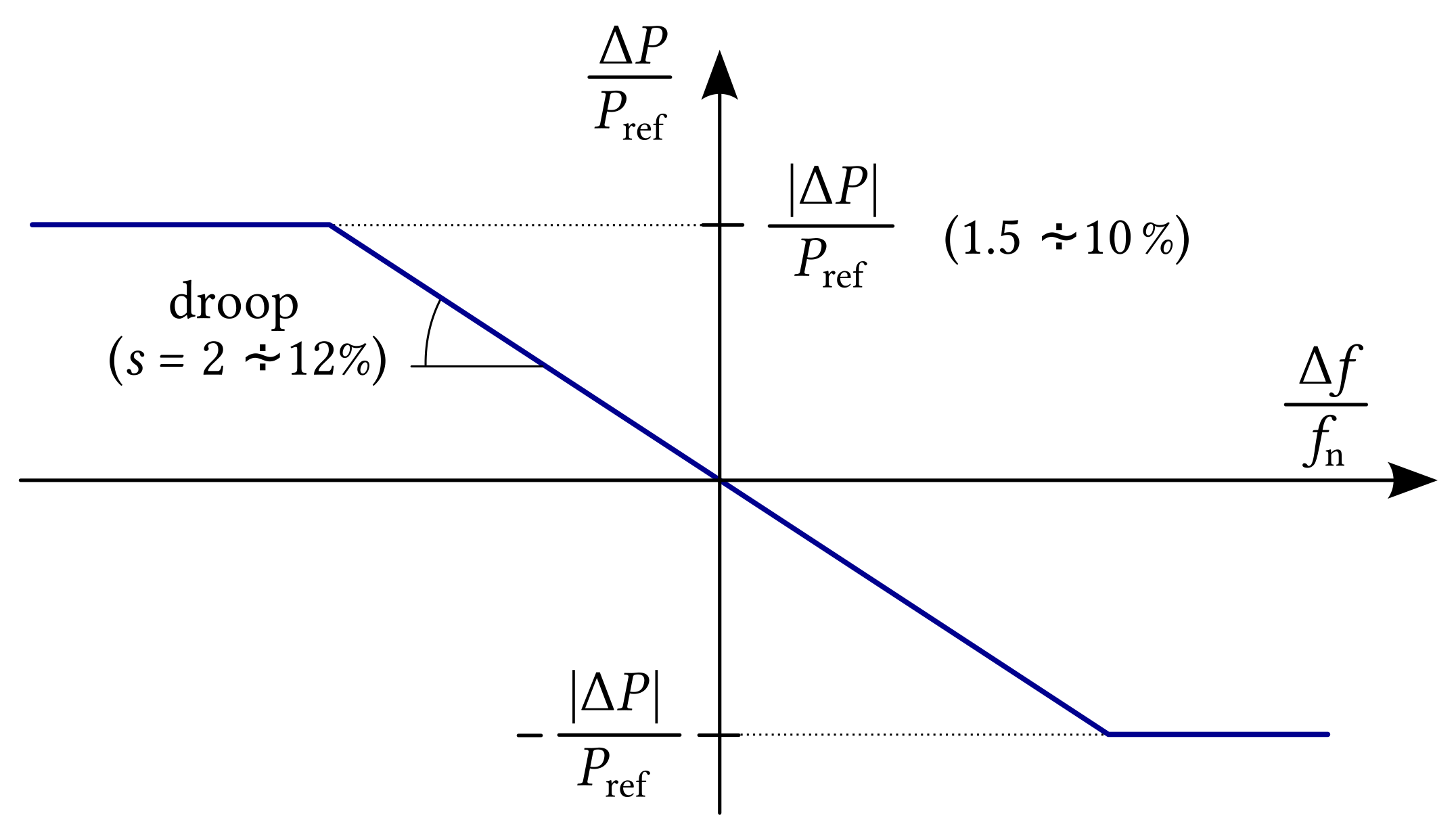
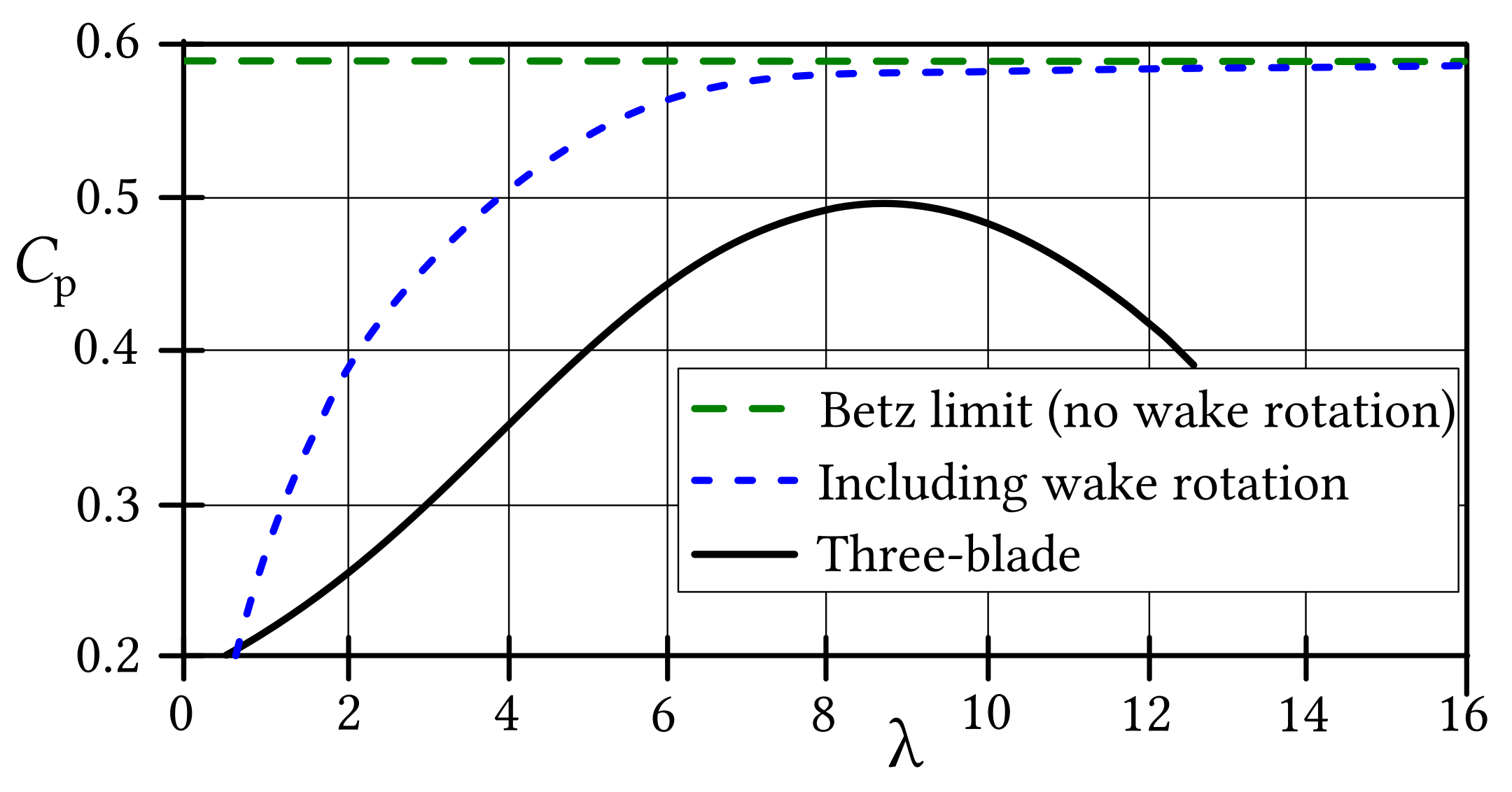
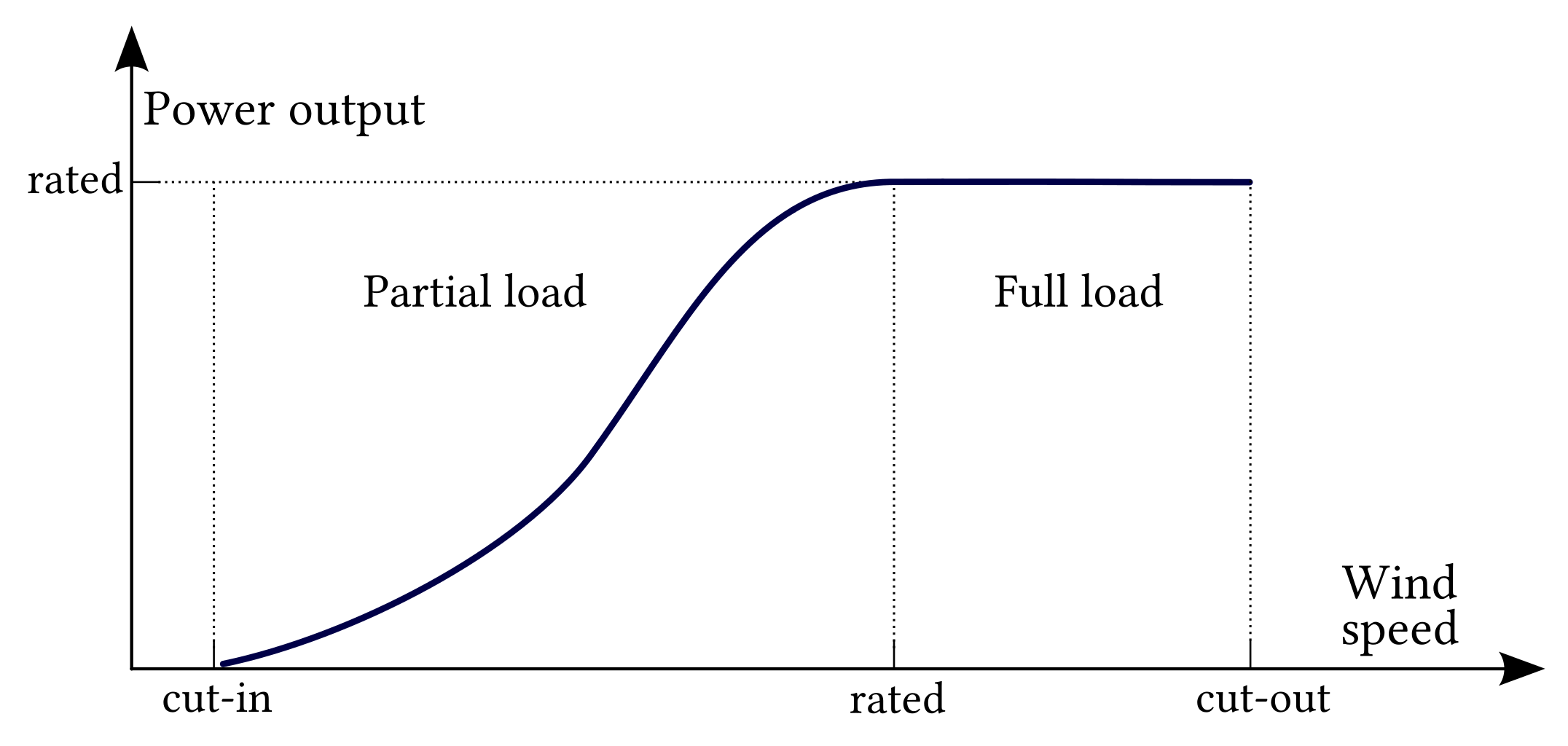
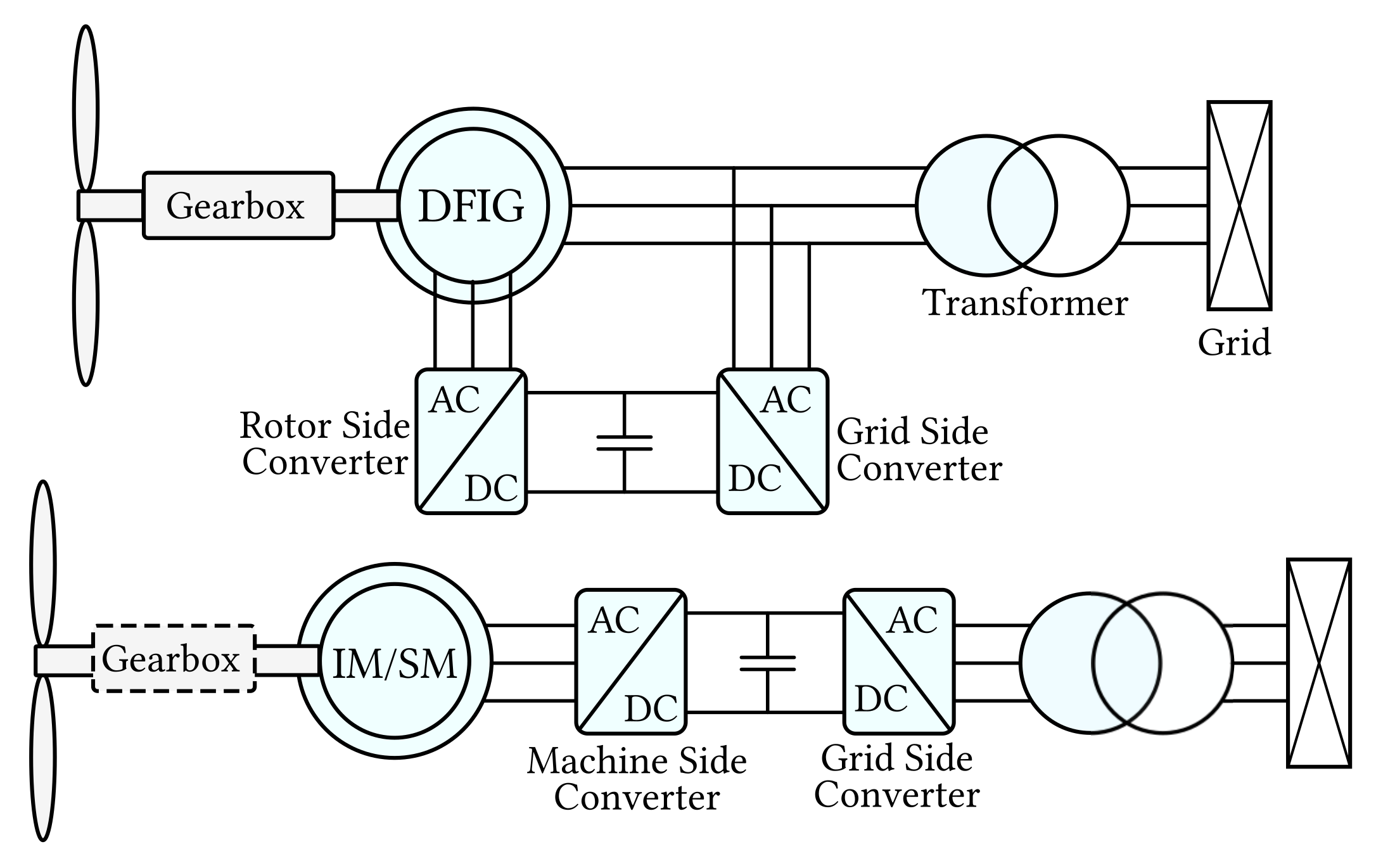

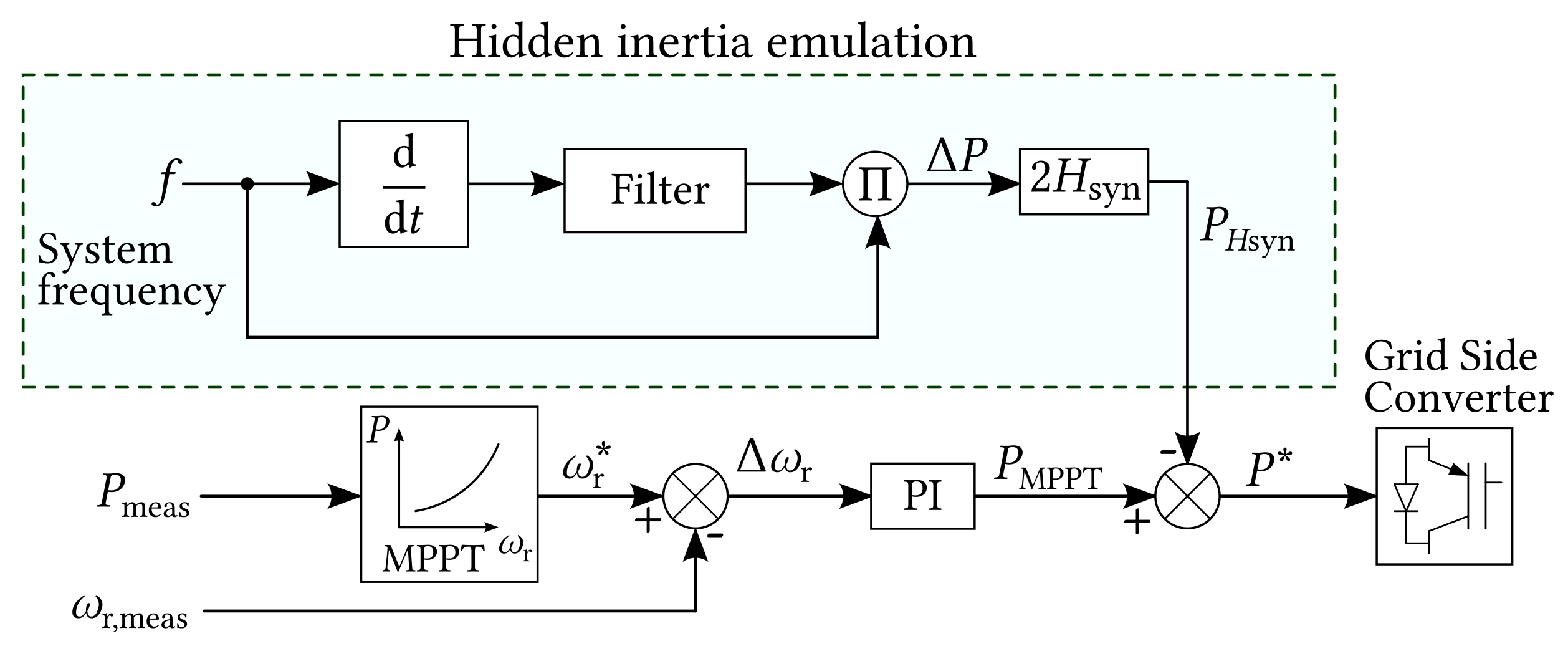

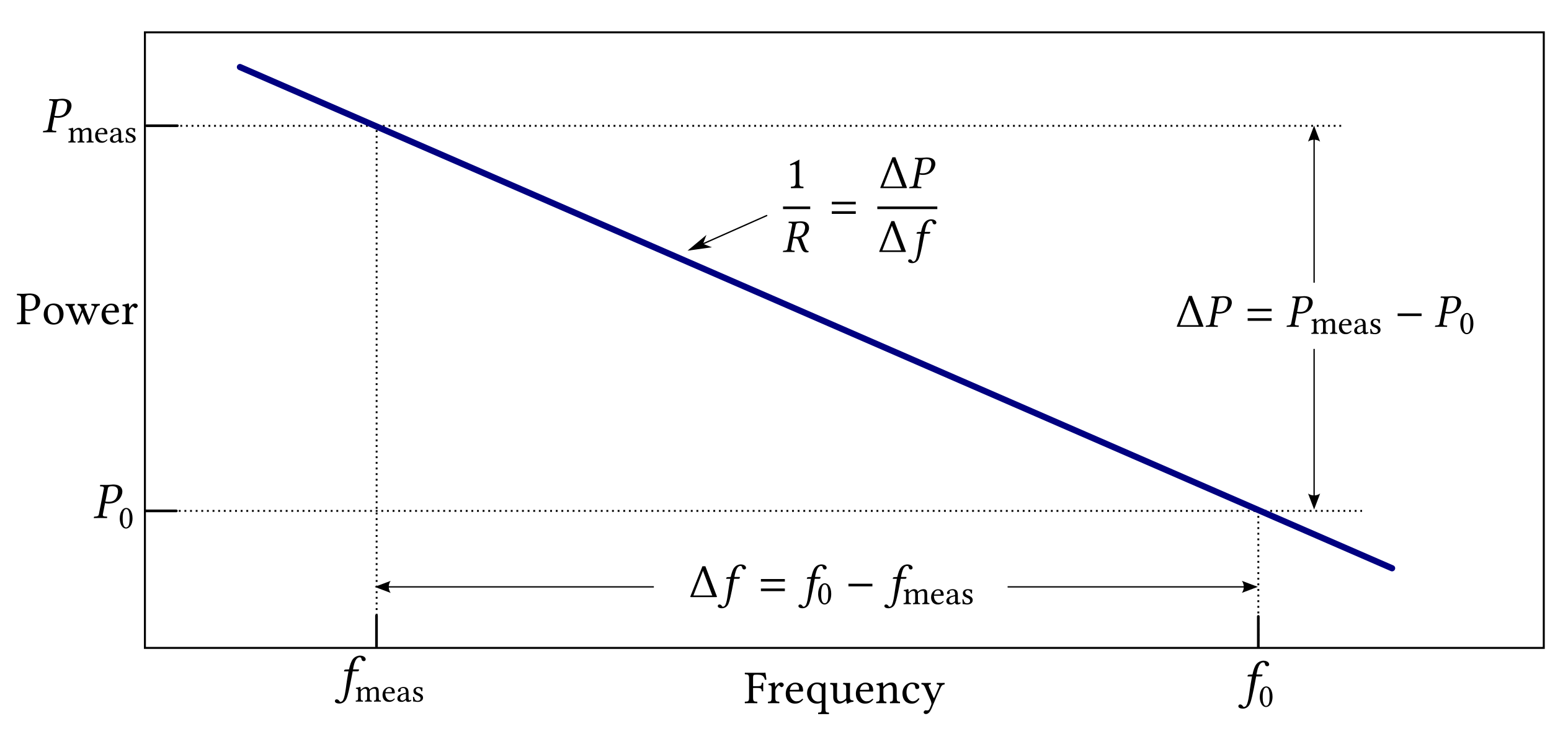







| Parameters | Ranges |
|---|---|
| Active power range related to maximum capacity | 1.5–10% |
| Frequency response insensitivity | 0.02–0.06% (10–30 mHz @ 50 Hz) |
| Frequency response deadband | 0–500 mHz |
| Droop | 2–12% |
Publisher’s Note: MDPI stays neutral with regard to jurisdictional claims in published maps and institutional affiliations. |
© 2021 by the authors. Licensee MDPI, Basel, Switzerland. This article is an open access article distributed under the terms and conditions of the Creative Commons Attribution (CC BY) license (https://creativecommons.org/licenses/by/4.0/).
Share and Cite
Fernández-Bustamante, P.; Barambones, O.; Calvo, I.; Napole, C.; Derbeli, M. Provision of Frequency Response from Wind Farms: A Review. Energies 2021, 14, 6689. https://doi.org/10.3390/en14206689
Fernández-Bustamante P, Barambones O, Calvo I, Napole C, Derbeli M. Provision of Frequency Response from Wind Farms: A Review. Energies. 2021; 14(20):6689. https://doi.org/10.3390/en14206689
Chicago/Turabian StyleFernández-Bustamante, Pablo, Oscar Barambones, Isidro Calvo, Cristian Napole, and Mohamed Derbeli. 2021. "Provision of Frequency Response from Wind Farms: A Review" Energies 14, no. 20: 6689. https://doi.org/10.3390/en14206689
APA StyleFernández-Bustamante, P., Barambones, O., Calvo, I., Napole, C., & Derbeli, M. (2021). Provision of Frequency Response from Wind Farms: A Review. Energies, 14(20), 6689. https://doi.org/10.3390/en14206689







